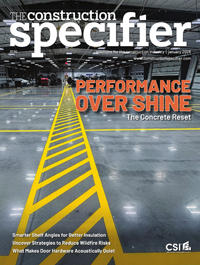Taking HVAC performance beyond the baseline: Combining geothermal, DOAS, and chilled beams

The DOAS energy recovery is even more critical to surpassing ASHRAE 90.1 at the Davis Building. The 19 lab hoods exhaust considerably more air than similarly sized conventional buildings, thus greater amounts of conditioned outdoor air are required to maintain building pressurization.
The building’s embedded 12-mm (½-in.) diameter cross-linked polyethylene (PEX) floor tubing leverages the thermal mass of the three-story building’s poured concrete. In this radiant system, piping under or inside the floor distributes the geothermal assembly’s water. The temperatures cool or heat the slab, which in turn radiates to the spaces above and below.
All combined, the chilled beams, radiant flooring, and DOAS provide even cooling and heating temperatures that are well within the six-degree Fahrenheit differential guidelines of ASHRAE 55, Thermal Environmental Conditions for Human Occupancy. The three systems draw from the 107-m (350-ft) deep, 40-well borefield’s three hydraulically separated geothermal earth heat exchangers using vertical loops of high-density polyethylene pipe (HDPE).
“We see a tremendous opportunity with chilled beams and geothermal, especially north of the Mason-Dixon line where inherent ground temperatures of mid-50s (i.e. 11 to 13 C) can be used in chilled beams and radiant systems,” said Hamstra, a geothermal design engineer with more than 464,500 m2 (5 million sf) of building space on his resumé. “Instead of the 20 EER (i.e. energy efficiency ratio) of a conventional chiller system operating a majority of the time, the University of Findlay system achieves an estimated 150 to 200 EER.”
The chiller, a 60-ton magnetic bearing model, runs about 20 percent less and is approximately four times smaller than a conventional chiller in a similar sized building, which helped reduce the project’s equipment capital costs. The resulting 65 m2 (700 sf)/ton is unprecedented for a science-oriented building with 15 draft hoods that were 1.2 to 1.8 m (4 to 6 ft) in length, according to Hamstra, who has specified three chilled beam projects.

The combination of a smaller chiller and no heat pumps, which are many times the more traditional geothermal choice over chilled beams, also complies and surpasses maximum pounds of refrigeration required by ASHRAE 15, Safety Code for Refrigeration Systems, and ASHRAE 34, Designation and Safety Classification of Refrigerants.
While these two standards are not new, the ever-changing scope of refrigerant types and quantities make the Davis Building environmentally cutting-edge for a facility its size. Additionally, both ASHRAE 15 and 34 are satisfied because Hamstra sized the building accurately and employed energy recovery (i.e. DOAS) and chilled beam technology to reduce the facility’s connected refrigeration load.
Indoor air comfort
Hamstra specified 49 active chilled beams in 1.2-, 1.8-, and 2.4-m (4-, 6-, and 8-ft) lengths. As the ceiling-mounted chilled beams quietly cool air around their coils, the cooler air sinks while warmer air rises in a perpetual room air mixing scenario superior in air comfort and energy efficiency compared to fan coils, variable air volume (VAV), and other forced air methods.
Installed by local mechanical contractor, Jack’s Heating A/C & Plumbing, the chilled beams have adjustable slots (nozzles) to address specific areas in its airflow range. The balance of air and water temperatures is all controlled by the building automation system (BAS). Hamstra also supplied each chilled beam room with a localized hot water reheat coil.
“We reset the DOAS’ discharge temperatures based on what most zones are calling for,” he explained. “The localized reheat coils can provide a more precise temperature required in that particular zone.”
The outdoor air supplied through the active chilled beams also prevents potential floor condensation from the radiant system. Hot water for the chilled beams and radiant system is supplied via chiller condenser heat recovery. An adjacent campus building’s conventional boiler serves as a backup, if needed.
Perhaps the most differentiating factor from other geothermal designs is the project’s intuitive Greensleeves’ in-house software that optimizes efficiencies beyond traditional BAS parameters. By analyzing considerations such as set-point temperatures and historical data, and then interpreting space needs, the software provides several levels of predictive control based on the present and future temperature and humidity conditions of the building load, the loop and outdoor environment, while also managing the geothermal borefield. For example, the software might signal the chiller to increase the temperature of the radiant system’s thermal mass on a morning where trends predict additional cooling will be needed in the afternoon.






